
Oxford Township is a township in Warren County, New Jersey, United States. As of the 2010 United States Census, the township's population was 2,514, reflecting an increase of 207 (+9.0%) from the 2,307 counted in the 2000 Census, which had in turn increased by 517 (+28.9%) from the 1,790 counted in the 1990 Census. It part of the easternmost region of the Lehigh Valley.
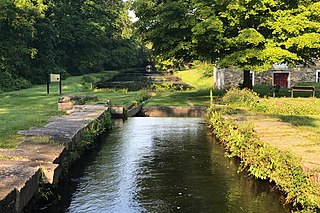
The Morris Canal (1829–1924) was a 107-mile (172 km) common carrier coal canal across northern New Jersey in the United States that connected the two industrial canals at Easton, Pennsylvania, across the Delaware River from its western terminus at Phillipsburg, New Jersey, to New York Harbor and the New York City markets via its eastern terminals in Newark and on the Hudson River in Jersey City, New Jersey.

Jack E. Boucher was an American photographer for the National Park Service for more than 40 years beginning in 1958. He served as the Chief Photographer for the Historic American Buildings Survey (HABS). In 1966 he left the Park Service for two years to supervise New Jersey's State Historic Preservation program, including the State's roadside marker program, 18 historic museum houses, several lighthouses, and two historic villages. Offered his old job back by the Park Service/HABS in 1970, he left New Jersey to return to NPS/HABS and the highly specialized job of large format photographic architectural documentation. His work took him to 49 States, the Virgin Islands and Puerto Rico. April 2008 was the fiftieth anniversary of his employment with the National Park Service's "HABS" program. He traveled with 900 pounds of photographic equipment.

Saugus Iron Works National Historic Site is a National Historic Site about 10 miles northeast of Downtown Boston in Saugus, Massachusetts. It is the site of the first integrated ironworks in North America, founded by John Winthrop the Younger and in operation between 1646 and approximately 1670. It includes the reconstructed blast furnace, forge, rolling mill, shear, slitter and a quarter-ton trip hammer.

Ringwood Manor, located in Passaic County, New Jersey, was the site of an ironworks and home to a number of well-known ironmasters from the 1740s to the late 19th century. The current manor house was not built until 1807.
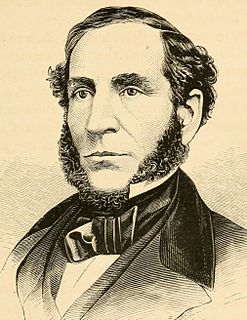
George Whitfield Scranton was an industrialist and politician, a Republican member of the U.S. House of Representatives from Pennsylvania from March 4, 1859, until his death in 1861. Moving to Pennsylvania in the late 1830s to establish an iron furnace, he and his brother Selden T. Scranton are considered among the founders of the city of Scranton, Pennsylvania, named for their family. They and two partners established what became known as the Iron & Coal Company. They developed a method of producing T-rails for constructing railroad track, which previously had been imported from England. The innovation led to a boom in production of track and construction of railroads.
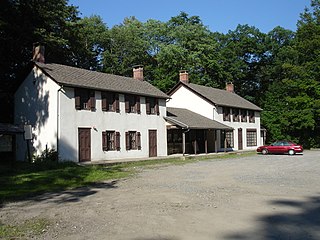
Long Pond Ironworks State Park is located in the community of Hewitt, in West Milford, New Jersey, United States. The park is known for its old stone walls, furnaces and other remnants of a once industrious ironworking community that now sits next to the swiftly flowing Wanaque River. The park is operated and maintained by the New Jersey Division of Parks and Forestry and has an area of 145 acres (0.59 km2).
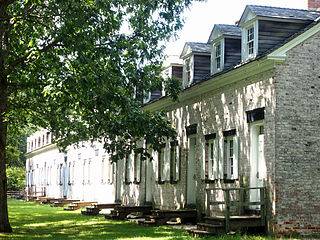
Allaire Village is a living history museum located within New Jersey's Allaire State Park in Wall Township, Monmouth County, New Jersey. The property was initially an Indian ceremonial ground prior to 1650, by 1750 a sawmill had been established on the property by Issac Palmer. The village was later established as a bog iron furnace originally known as Williamsburg Forge 'Monmouth Furnace' was then renamed the Howell Works by Benjamin B. Howell. In 1822, it was then purchased by philanthropist James P. Allaire, who endeavoured to turn into a self-contained community. The wood burning furnace business collapsed in 1846 and the village closed. During its height, the town supported about 500 people. Following his death, the property passed through a number of family members before being used by the Boy Scouts who started to restore the buildings for use as a summer camp. Losing the lease, the property then passed to the State of New Jersey. Allaire Village and its existing buildings are now operated by a non-profit organization - Allaire Village, Inc. Historic interpreters work using period tools and equipment in the blacksmith, tinsmith, and carpentry shops, while the old bakery sells cookies, and general store serves as a museum store. The church building is frequently used for weddings. The site is also host to community events such as community band concerts, Antique sale, weekly Flea Markets and Square Dance Competitions.

Principio Furnace and village is in Cecil County, Maryland, 4 miles (6.4 km) northeast of Havre de Grace, MD.
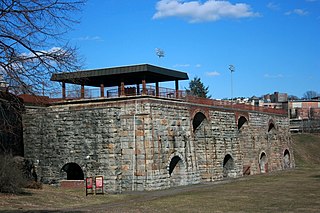
The Scranton Iron Furnaces is a historic site that preserves the heritage of iron making in the U.S. State of Pennsylvania and is located in Scranton, near the Steamtown National Historic Site. It protects the remains of four stone blast furnaces which were built between 1848 and 1857. Iron production on the site was started by Scranton, Grant & Company in 1840. Later, the furnaces were operated by the Lackawanna Iron & Coal Company. In 1847, iron rails for the Erie Railroad were made at the site. In 1865, Scranton, Grant & Company had the largest iron production capacity in the United States. In 1875, steel production started at the site. In 1880, the furnaces produced 125,000 tons of pig iron, one of the main uses of which was in the making of t-rails. The plant was closed in 1902, when production was shifted to Lackawanna, New York.

The William Trent House is a historic building located at 15 Market Street in Trenton, Mercer County, New Jersey. It was built in 1719 for William Trent and is the oldest building in Trenton. He founded the eponymous town, which became the capital of New Jersey. It has served as the residence for three Governors. The house was added to the National Register of Historic Places and listed as a National Historic Landmark on April 15, 1970, for its significance as an example of Early Georgian Colonial architecture.
The Ghost Town Trail is a rail trail in Western Pennsylvania that runs 36 miles (58 km) between Black Lick, Indiana County, and Ebensburg, Cambria County. Established in 1991 on the right-of-way of the former Ebensburg and Black Lick Railroad, the trail follows the Blacklick Creek and passes through many ghost towns that were abandoned in the early 1900s with the decline of the local coal mining industry. Open year-round to cycling, hiking, and cross-country skiing, the trail is designated a National Recreation Trail by the United States Department of the Interior.

Shippen Manor is located in Oxford Township, Warren County, New Jersey, United States. The manor was built in 1755 and was added to the National Register of Historic Places on December 20, 1984. It was later added as a contributing property to the Oxford Industrial Historic District on August 27, 1992.

Isabella Furnace was a cold blast charcoal iron furnace located in West Nantmeal Township, Chester County, Pennsylvania. The furnace was named for Isabella Potts, wife of one of the partners, a member of the Potts ironmaking family. Isabella was the last iron furnace to be built in the county, in 1835, and was operated by members of the Potts family and their partners until 1855, when they lost control of it in a bankruptcy. It returned to the family in 1881, when it was purchased by Col. Joseph Potts, who modernized it. The furnace, the last to operate in Chester County, went out of blast in 1894, a few months after Col. Potts' death, but remained largely intact until after his son's death in 1943. The remains of the furnace complex have been listed in the National Register of Historic Places since 1991.

Farrandsville is an unincorporated community in Colebrook Township in Clinton County in the U.S. state of Pennsylvania. It is on the north side of the West Branch Susquehanna River about 4 miles (6 km) upstream from Lock Haven at the north end of Farrandsville Road. Whisky Run and Lick Run flow through Farrandsville.
Scotts Mountain is a mountain in Warren County, New Jersey. The mountain covers portions of Harmony, Lopatcong, Franklin and Washington Townships; the main summit rises to 1,086 feet (331 m), and is located in Harmony. It is part of the New York–New Jersey Highlands of the Appalachian Mountains, although somewhat isolated to the west of the main body of the Highlands.

William Walker Scranton was an American businessman based in Scranton, Pennsylvania. He became president and manager of the Lackawanna Iron and Coal Company after his father's death in 1872. The company had been founded by his father's cousin George W. Scranton. Among his innovations, Scranton adopted the Bessemer process for his operations in 1876, greatly increasing production of steel ties with a new mill. Scranton founded the Scranton Steel Company, in 1891 consolidated as Lackawanna Iron and Steel Company. The steel company became the second largest in the nation. He later also managed the Scranton Gas and Water Company, developing a secure water supply outside the city by creating Lake Scranton.

The Oxford Industrial Historic District is a historic district primarily located in Oxford Township in Warren County, New Jersey. It also extends into Mansfield Township and Washington Township. The district was added to the National Register of Historic Places on August 27, 1992 for its significance in community development, industry, and transportation from 1741 to 1930. It includes 385 contributing buildings, three contributing structures, and six contributing sites.
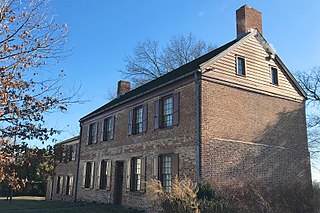
The Van Veghten House is a historic building in the Finderne section of Bridgewater Township, New Jersey. The house was built c. 1725 and served as the headquarters of Quartermaster General Nathanael Greene during the second Middlebrook encampment (1778–79) in the American Revolutionary War. The Somerset County Historical Society owns the house and uses it as its headquarters, including a museum and library. The early-18th-century Old York Road, connecting Philadelphia to New York City, passed by here. The house was added to the National Register of Historic Places on October 10, 1979, and noted as representing "one of the few remaining Raritan River mansions".

Kennedy Mills, also spelled Kennedy's Mills, is an unincorporated community located at the intersection of New Jersey Route 173 and the Pohatcong Creek in Greenwich Township, Warren County, New Jersey. The road parallels the stage coach route built in 1806, known as the New Jersey Turnpike, running between Easton, Pennsylvania and New Brunswick, New Jersey.



































